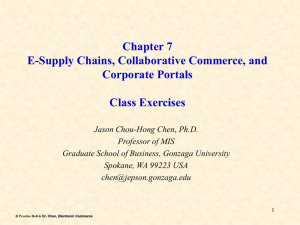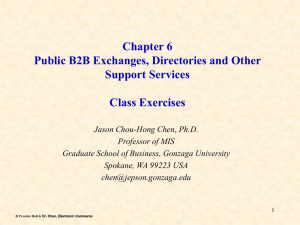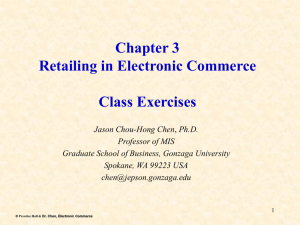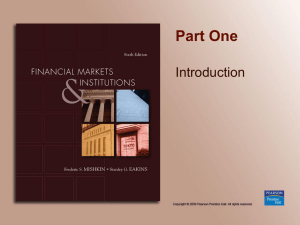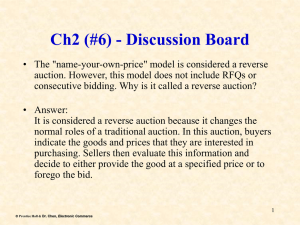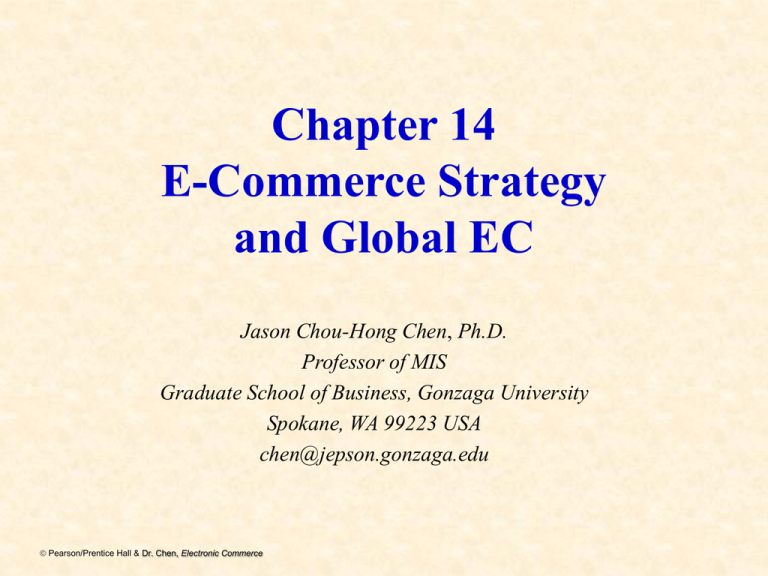
Chapter 14
E-Commerce Strategy
and Global EC
Jason Chou-Hong Chen, Ph.D.
Professor of MIS
Graduate School of Business, Gonzaga University
Spokane, WA 99223 USA
chen@jepson.gonzaga.edu
Pearson/Prentice Hall & Dr. Chen, Electronic Commerce
Learning Objectives
1.
2.
3.
4.
5.
6.
7.
Describe the strategic planning process.
Describe the purpose and content of a business plan.
Understand how e-commerce impacts the strategic
planning process.
Understand how to formulate, justify, and prioritize EC
applications.
Describe strategy implementation and assessment,
including the use of metrics.
Evaluate the issues involved in global EC.
Analyze the impact of EC on small and medium-sized
businesses.
Pearson/Prentice Hall & Dr. Chen, Electronic Commerce
14.1 Organizational Strategy:
Concepts and Overview
• Strategy: A broad-based formula for how a
business is going to compete, what its goals
should be, and what plans and policies will
be needed to carry out those goals
• Strategy is also about making tough
decisions about what not to do
Pearson/Prentice Hall & Dr. Chen, Electronic Commerce
Planning is everything ...
develop
Customers,
market,
competition
Vision
guide
Strategy
create
Tactic
Products,
Services
N
Pearson/Prentice Hall & Dr. Chen, Electronic Commerce
Focusing Marketing Strategy and Evaluating
Market Opportunities
Opportunities to be turned Into
marketing strategies and plans
Evaluating Opportunities
Focusing marketing
Strategy
Defining generic
markets and
product-markets
Targeting
and
Segmentation
Pearson/Prentice Hall & Dr. Chen, Electronic Commerce
S.W.O.T
Analysis
Positioning
and
Differentiation
Company
mission,
objectives,
resources
Develop product market
Screening criteria
Competitor
analysis
Trends in external
environment:
Technological,
Economic,
Political & Legal
Cultural & Social
Organizational Strategy (cont.)
• Profitability and economic value is
determined by establishing a unique
value proposition
• Strategy is focused on questions about:
–
–
–
–
organizational fit
trade-offs
profitability
value
Pearson/Prentice Hall & Dr. Chen, Electronic Commerce
Organizational Strategy:
Concepts and Overview
• Strategy and the Web Environment
– e-commerce strategy (e-strategy)
The formulation and execution of a vision of
how a new or existing company intends to do
business electronically
Pearson/Prentice Hall & Dr. Chen, Electronic Commerce
Organizational Strategy:
Concepts and Overview
• Strategy and the Web Environment
– strategic information systems planning
(SISP)
A process for developing a strategy and plans
for aligning information systems (including ecommerce applications) with the business
strategies of an organization
Pearson/Prentice Hall & Dr. Chen, Electronic Commerce
Organizational Strategy
Exhibit 14.1 The Strategic planning Process
Strategy
Initiation
(section 14.4)
Strategy
Assessment
(section 14.7)
Strategy
Formulation
(section 14.5)
Strategy
Implementation
(section 14.6)
Pearson/Prentice Hall & Dr. Chen, Electronic Commerce
Systems Development Life Cycle (SDLC)
Understand the
Business
Problem or
Opportunity
Develop an
Information
System
Solution
Systems Investigation
Product:
Feasibility Study
Systems Analysis
Product:
Functional Requirements
Systems Design
Product:
System Specifications
Implement
the Information
System
Solution
Systems Implementation
Product:
Operational System
Systems Maintenance
Pearson/Prentice Hall & Dr. Chen, Electronic Commerce
Product:
Improved System
Strategic planning process
•
Strategy initiation: The initial phase of
strategic planning in which the
organization examines itself and its
environment
–
Value proposition: The benefit that a
company’s products or services provide to
customers; the consumer need that is being
fulfilled
Pearson/Prentice Hall & Dr. Chen, Electronic Commerce
Essentials for a Successful Enterprise
competition
structure/
culture
Value propositions
1. Business model
Business landscape
Internal/
External
fulfill
2. Core competencies
Strategic intent
Analysis
(Porter, SWOT)
Technology
H/R
Management
Process
Finance
…
future positioning
Strategy
3. Execution
Corporate strategy
•Positioning on product/market
Business strategy
•Differentiation/choice of
competitive advantage
Functional strategy
IT Role?
Pearson/Prentice Hall & Dr. Chen, Electronic Commerce
Positioning
•Competitive posture
Industry characteristics,
Market growth,
Demand characteristics,
Barrier of entry,etc.
N
Strategic planning process (cont.)
• Outcomes from strategy initiation phase
– Company analysis (including value
proposition)
– Core competencies
– Forecasts
– Competitor (industry) analysis
Pearson/Prentice Hall & Dr. Chen, Electronic Commerce
Strategic planning process (cont.)
• Strategy formulation: The development of
strategies to exploit opportunities and
manage threats in the business environment
in light of corporate strengths and
weaknesses
• Specific activities and outcomes from
strategy formulation phase:
– Business opportunities
– Cost-benefit analysis
– Risk analysis, assessment, and management
Pearson/Prentice Hall & Dr. Chen, Electronic Commerce
Strategic planning process (cont.)
• Strategy implementation: The development
of detailed, short-term plans for carrying out
the projects agreed on in strategy
formulation
• Specific activities and outcomes from
strategy implementation phase:
– Business planning
– Resource allocation
– Project management
Pearson/Prentice Hall & Dr. Chen, Electronic Commerce
Strategic planning process (cont.)
• Strategy assessment: The continuous
evaluation of progress toward the
organization’s strategic goals, resulting in
corrective action and, if necessary, strategy
reformulation
Specific measures called metrics are used to
assess the progress of the strategy
Pearson/Prentice Hall & Dr. Chen, Electronic Commerce
Strategic planning tools
1. SWOT analysis: A methodology that
surveys external opportunities and threats
and relates them to internal strengths and
weaknesses
Pearson/Prentice Hall & Dr. Chen, Electronic Commerce
Strategic planning tools (cont.)
• 2. Competitor analysis grid: A strategic
planning tool that highlights points of
differentiation between competitors and the
target firm
• 3. Scenario planning: A strategic planning
methodology that generates plausible
alternative futures to help decision makers
identify actions that can be taken today to
ensure success in the future
Pearson/Prentice Hall & Dr. Chen, Electronic Commerce
Strategic planning tools (cont.)
• 4. Balanced scorecard: An adaptive tool
that assesses organizational progress toward
strategic goals by measuring performance in
a number of different areas
• 5. (extra) Return on investment (ROI): A
ratio of required costs and perceived
benefits of a project or an application
Pearson/Prentice Hall & Dr. Chen, Electronic Commerce
A Marketing Strategy –
showing the 4 P’s of a Marketing Mix
Product
Place
C
Price
Pearson/Prentice Hall & Dr. Chen, Electronic Commerce
Promotion
Overview of Marketing Strategy Planning Process
Narrowing down to focused strategy with quantitative and qualitative screening criteria
Customers
Needs and other
Segmenting
Dimensions
Company
Objectives
&
Resources
S.
W.
O.
T.
Segmentation &
Targeting
Place
C
Segmentation &
Positioning
Competitors
Current
&
Prospective
External Market Environment
Technologies Political and Legal Cultural and Social Economic
Pearson/Prentice Hall & Dr. Chen, Electronic Commerce
Product
Price
Promotion
14.2 Business Planning in ECommerce
• business plan
A written document that identifies the
company’s goals and outlines how the
company intends to achieve those goals
Pearson/Prentice Hall & Dr. Chen, Electronic Commerce
Business Planning in E-Commerce
• Outline of a business plan
–
–
–
–
–
–
Executive Summary
Business Description
Operations Plan
Financial Plan
Marketing Plan
Competitor Analysis
Pearson/Prentice Hall & Dr. Chen, Electronic Commerce
Business Planning in E-Commerce
• Business Plan Fundamentals
– Purposes for business plan
• To acquire funding
• To acquire nonfinancial resources
• To obtain a realistic approach to the business
• business case
A business plan for a new initiative or large,
new project inside an existing organization
Pearson/Prentice Hall & Dr. Chen, Electronic Commerce
14.3 E-Commerce Strategy:
Concepts and Overview
Pearson/Prentice Hall & Dr. Chen, Electronic Commerce
IT Planning: The Relationship Between Business, IS,
and IT Strategies
IT
Impact
and
potential
Business Strategy
• Business Decisions
• Objectives and Direction
• Change
Supports
business
Direction for
business
IS Strategy
• Business Based
• Demand Orientated
• Application Focused
Infrastructure
And services
What is
required
Needs and
priorities
IT Strategy
• Activity Based
Pearson/Prentice Hall & Dr. Chen, Electronic Commerce
Where is the
business
going and
why
• Supply Orientated
• Technology Focused
How it
can be
delivered
BREAK
• Application Case 14.1: Strategic Planning at
InternetNZ (p.644)
Pearson/Prentice Hall & Dr. Chen, Electronic Commerce
14.4 E-Strategy Initiation
• Issues in E-Strategy Initiation
–
–
–
–
–
Be a First Mover or a Follower?
Born-on-the-Net or Move-to-the-Net?
Determining Scope
Have a Separate Online Company?
Have a Separate Online Brand?
Pearson/Prentice Hall & Dr. Chen, Electronic Commerce
Technology Acceptance Model
Perceived
Usefulness
Attitude
Toward Using
External
Variables
Behavioral
Intention to
Use
Actual
System
Use
Perceived
Ease of Use
Pearson/Prentice Hall & Dr. Chen, Electronic Commerce
N
The new technology adoption curve
Readiness
Level of
Activity
Time
Pearson/Prentice Hall & Dr. Chen, Electronic Commerce
Intensification
Impact
Keen’s Six-Stage Competitive Advantage Model
Stimulus for action
First major move
Customer acceptance
Competitor catch-up moves
First-mover expansion moves
Commoditization
Pearson/Prentice Hall & Dr. Chen, Electronic Commerce
N
When to Perform Activities
• First Movers
Advantages
•Build brand recognition
•Control scarce resources
•Establish networks
•Early Economies-of-Scale
Pearson/Prentice Hall & Dr. Chen, Electronic Commerce
Disadvantages
•Newer technology
•Higher development costs
•Reverse engineering by
competitors
Winners vs. Losers
• What separates winners from losers in creating
(ultimate) strategic competitive advantage is
neither bleeding-edge technology nor “timing for
market entry.”
• It is from “value innovation”
utility
Firm
Innovation
price
cost
Pearson/Prentice Hall & Dr. Chen, Electronic Commerce
Value
Innovation
14.5 E-Strategy Formulation
•
Selecting EC Opportunities
–
Incorrect approaches to EC strategy selection:
1.
2.
3.
–
Indiscriminately funding many projects and hoping for a few
winners
Betting it all in a single, high-stakes initiative
“Trend-surfing”
Productive approaches to EC strategy selection
1.
2.
3.
4.
Problem-driven strategy
Technology-driven strategy
Market-driven strategy
E-business maturity model
Pearson/Prentice Hall & Dr. Chen, Electronic Commerce
E-Strategy Formulation
• Determining an Appropriate EC
Application Portfolio Mix
– The BCG model
– An Internet portfolio map for selecting
applications
Pearson/Prentice Hall & Dr. Chen, Electronic Commerce
E-Strategy Formulation
Exhibit 14.6 Internet Portfolio Map
Viability of Project
High
Low
Pearson/Prentice Hall & Dr. Chen, Electronic Commerce
Sell
project
Adopt
project
Reject
project
Redesign
project
Company Fit
High
E-Strategy Formulation
• Risk Analysis and Management
– e-commerce (EC) risk
The likelihood that a negative outcome will
occur in the course of developing and operating
an electronic commerce strategy
– Security issues
Pearson/Prentice Hall & Dr. Chen, Electronic Commerce
E-Strategy Formulation
• Issues in Strategy Formulation
– How to handle channel conflict
– How to handle conflict between the off-line and online
businesses
– Pricing strategy
•
•
•
•
Price comparison is easier
Buyers sometimes set the price
Online and off-line goods are priced differently
Differentiated pricing can be a pricing strategy
– versioning
Selling the same good, but with different selection and delivery
characteristics
Pearson/Prentice Hall & Dr. Chen, Electronic Commerce
Key Factors that Influence Price Setting
Pricing
objectives
Price of other
products in the line
Pricing flexibility
Discounts and
allowances
Demand
Price
Setting
Cost
Geographic
pricing terms
Competition
Markup chain
in channels
Pearson/Prentice Hall & Dr. Chen, Electronic Commerce
Legal
environment
Strategy Planning for Price
Target
Market
Product
Place
Promotion
Price
Price
objectives
Price
flexibility
Pearson/Prentice Hall & Dr. Chen, Electronic Commerce
Price levels
over product
life cycle
Discounts and
allowances -to whom
and when
Geographic
Term -who pays
transportation
and how
14.6 E-Strategy Implementation
• Create a Web Team
– project champion
The person who ensures the EC project gets the
time, attention, and resources required and
defends the project from detractors at all times
• Start with a Pilot Project
• Allocate Resources
• Manage the Project
Pearson/Prentice Hall & Dr. Chen, Electronic Commerce
14.6 E-Strategy Implementation
• Strategy Implementation Issues
– Application development
– Partners’ strategy
• outsourcing
The use of an external vendor to provide all or part
of the products and services that could be provided
internally
Pearson/Prentice Hall & Dr. Chen, Electronic Commerce
EC Strategy
Implementation Issues (cont.)
• Partners’ strategy
Outsourcing: The use of a third-party vendor
to provide all or part of the products and
services that could be provided internally
• Two drivers
– focus
on core business
– value
shareholder
Pearson/Prentice Hall & Dr. Chen, Electronic Commerce
When to Outsourcing?
• Which IS activities are strategic to our company's
business?
• Will outsourcing save us at least 15 percent?
• Does our firm have access to the needed technology
and expertise?
– If not, outsourcing may be the answer to acquiring
these resources.
• Does outsourcing increase our firm's flexibility?
Pearson/Prentice Hall & Dr. Chen, Electronic Commerce
Dr. Chen, Managing IT Reos. Thru Strategic Partnerships; A Portoflio Approach to IT Development
TM -44
Going Offshore for IS Development
• When the MIS organization uses contractor services, or
even builds its own data center in a distant land, it is
engaged in offshoring, which is short for outsourcing
offshore.
• The types of tasks that are outsourced are usually those
that can be well-specified; however, nowdays, the
functions sent offshore range from routine IT
transactions to increasingly higher end, knowledgebased processes.
• Countries such as India, the Philippines, etc, offer
“offshoring”, an alternative to in-house systems
development
• It raises the issue of what to send offshore, and what to
keep within your enterprise MIS organization.
Pearson/Prentice Hall & Dr. Chen, Electronic Commerce
Strategic Grid for
Decisions on Outsourcing
Strategic Importance
Y
Competitive Advantage
Y
N
Pearson/Prentice Hall & Dr. Chen, Electronic Commerce
N
Strategic Grid for
Decisions on Outsourcing
Strategic Importance
Competitive Advantage
Y
N
Y
N
Insourcing
Leverage
Strategic
Alliance
Pearson/Prentice Hall & Dr. Chen, Electronic Commerce
(K-How to partners)
Outsourcing
Summary: Factors driving outsourcing
1. Cost savings
2. Qualified IT staff are difficult to find and retain
3. By bringing in outside expertise, management
needs to focus less on IS operations and more on
the information itself.
4. Outsourcers are specialists, should understand
how to manage IS staff more effectively.
5. Outsourcers may have larger IS resources that
provide greater capacity on demand.
6. Outsourcing can help a company overcome
inertia to consolidate data centers that could not
be consolidated by an internal group, or
following a merger or acquisition.
Pearson/Prentice Hall & Dr. Chen, Electronic Commerce
E-Strategy Implementation
• Business alliances and virtual corporations
virtual corporation (VC)
– An organization composed of several business partners
sharing costs and resources for the production or
utilization of a product or service
– co-opetition
Two or more companies cooperate together on some
activities for their mutual benefit, even while competing
against each other in the marketplace
Pearson/Prentice Hall & Dr. Chen, Electronic Commerce
EC Strategy
Implementation Issues (cont.)
A Virtual Corporation (VC) is an Organization
Composed of several Business Partners that Uses
Information Technology to Link/Share People,
Assets, Ideas, Costs, and Resources
for the purpose of producing a product or service.
Virtual Companies are Adaptable and OpportunityExploiting Organizations Providing World-Class
Excellence in Their Competencies and
Technologies.
Pearson/Prentice Hall & Dr. Chen, Electronic Commerce
VIRTUAL ORGANIZATION
MANUFACTURING
DESIGN
COMPANY
COMPANY
SALES & MARKETING
COMPANY
CORE
COMPANY
LOGISTICS
COMPANY
FINANCE COMPANY
N
Pearson/Prentice Hall & Dr. Chen, Electronic Commerce
TM -51
Characteristics of Virtual
Corporations
Excellence
Borderless
Adaptability
Six
Characteristics
of Virtual
Companies
Opportunism
Trust-Based
Technology
Utilization
Pearson/Prentice Hall & Dr. Chen, Electronic Commerce
N
E-Strategy Implementation
– Redesigning business processes
• business process reengineering (BPR)
A methodology for conducting a comprehensive
redesign of an enterprise’s processes
Pearson/Prentice Hall & Dr. Chen, Electronic Commerce
E-Strategy Implementation
– business process management (BPM)
Method for business restructuring that
combines workflow systems and redesign
methods; covers three process categories—
people-to-people, systems-to-systems, and
systems-to-people interactions
Pearson/Prentice Hall & Dr. Chen, Electronic Commerce
14.7 E-Strategy and Project
Assessment
• The Objectives of Assessment
– Measure the extent to which the EC strategy and
ensuing projects are delivering what they were
supposed to deliver
– Determine if the EC strategy and projects are still
viable in the current environment
– Reassess the initial strategy in order to learn from
mistakes and improve future planning
– Identify failing projects as soon as possible and
determine why they failed
Pearson/Prentice Hall & Dr. Chen, Electronic Commerce
E-Strategy and Project Assessment
• Measuring Results and Using Metrics
– metric
A specific, measurable standard against which
actual performance is compared
– corporate (business) performance
management (CPM, BPM)
Advanced performance measuring and analysis
approach that embraces planning and strategy
Pearson/Prentice Hall & Dr. Chen, Electronic Commerce
E-Strategy
and Project
Assessment
Pearson/Prentice Hall & Dr. Chen, Electronic Commerce
E-Strategy and Project Assessment
• Web analytics
The analysis of clickstream data to
understand visitor behavior on a Web site
Pearson/Prentice Hall & Dr. Chen, Electronic Commerce
Exhibit 14.8 Blueprint of the Performance Dashboard (P.664)
Develop resource system required to deliver the strategy
Define goals and value proposition
Step One:
Articulate Business
Strategy
Step Two:
Translate Strategy
Into Desired Outcome
Step Three:
Devise Metrics
Market opportunity
•Opportunity
•Competitive
environment
Market Opportunity
• Market size and growth
• Average age and income
•Competitor concentration
Business Model
•Unique value proportion?
•Capabilities vs. competition
Business Model
•Customer perceived benefit
•Exclusive partnerships
•$ invested in technology vs.
competition
Implementing
and Branding
•How to develop brand?
•How to go to market?
Implementation
•Customer brand awareness
•System uptime percentage
•Number of IT staff
•% inaccurate orders
Customer
•How to acquire customers?
•How will customers change?
•How to improve the
customer experience?
Customer
•Market share
•Purchase/year
•Success rate
•Service requests/customers
Financial
•Financial consequences in
terms of revenue, profit,
cost, and balance sheet?
Financial
•Revenue
•Profit
•Earning per share
•Debt to equity ratio
Pearson/Prentice Hall & Dr. Chen, Electronic Commerce
Step Four:
Link Metrics to leading
And lagging indicators
•For each metric,
determine the
metrics that it affects
and that affect it.
•Map the linked set of
•Metrics, indicating
leading and lagging
indicators.
•Ensure that there is
a balance between
leading and lagging
indicator.
Step Five:
Calculate Current and
Target Performance
•For each metric,
calculate the level
of performance.
•Determine target
level required to
meet outcomes
described in Step
Two.
•Ensure that target
are consistent with
each other.
14.8 Global E-Commerce
• Benefits and Extent of Operations
– The major advantage of EC is the ability to do
business at any time, from anywhere, and at a
reasonable cost
Pearson/Prentice Hall & Dr. Chen, Electronic Commerce
Global E-Commerce
• Barriers to Global EC
–
–
–
–
–
Cultural issues
Culture and language translation
Administrative issues
Geographic issues and localization
Economic issues
Pearson/Prentice Hall & Dr. Chen, Electronic Commerce
Global E-Commerce
• Breaking Down the Barriers to Global
EC
–
–
–
–
–
–
–
Be strategic
Know your audience
Localize
Think globally, act consistently
Value the human touch
Clarify, document, explain
Offer services that reduce barriers
Pearson/Prentice Hall & Dr. Chen, Electronic Commerce
E-Commerce in Small and MediumSized Enterprises
• Advantages and Benefits of EC to Small and
Medium-Sized Enterprises
– Inexpensive sources of information
– Inexpensive ways of advertising and conducting market
research
– Competitor analysis is easier
– Inexpensive ways to build storefronts
– Less locked into legacy technologies
– Image and public recognition can be generated quickly
– An opportunity to reach worldwide customers
Pearson/Prentice Hall & Dr. Chen, Electronic Commerce
14.9 E-Commerce in Small and
Medium-Sized Enterprises
• Disadvantages and Risks of EC to Small and
Medium-Sized Enterprises
– Lack of financial resources to fully exploit the Web
– Lack of technical staff or insufficient expertise in legal
issues, advertising, etc.
– Less risk tolerance than a large company.
– Products not suitable for online sales
– Reduced personal contact with customers
– Inability to afford the advantages of digital exchanges
Pearson/Prentice Hall & Dr. Chen, Electronic Commerce
E-Commerce in Small and MediumSized Enterprises
• Critical Success Factors for SMES
–
–
–
–
Product is critical
Payment methods must be flexible
Electronic payments must be secure
Capital investment should be kept to a
minimum
– Inventory control is crucial
– Logistics services must be quick and reliable
Pearson/Prentice Hall & Dr. Chen, Electronic Commerce
E-Commerce in Small and MediumSized Enterprises
• Critical Success Factors for SMES
–
–
–
–
Owner support
High visibility on the Internet
Join an online community
A Web site should provide all the services
needed by consumers
• Supporting SMES
– Government agencies
– Vendor service centers
Pearson/Prentice Hall & Dr. Chen, Electronic Commerce
The Key to successful business
on the Internet ...
• The key to successful business on the Internet
is not the formulation of a conceptual strategy
but the execution of that strategy – the content owners must buy into the strategy and
have the confidence of senior executives,
– often the decisions the content owners make may
have serious consequences to the organization
and its strategy
– Buy-in and open discussions are keys to success
Robert Plant, eCommerce: Formulation of Strategy, pp.67, 1999, Prentice Hall
Pearson/Prentice Hall & Dr. Chen, Electronic Commerce
Ownership Issues
• E-centric Structure + Content = Success
Content alone is not sufficient for success
Successes come from a balanced business model
that involves each business area content provider
contributing to the overall business model.
Content is Knowledge,
Knowledge is Power.
Pearson/Prentice Hall & Dr. Chen, Electronic Commerce
N
BREAK
• Application Case 14.3: Web Page
Translation at the Denver Metro Convention
and Visitors Bureau (p.667)
Pearson/Prentice Hall & Dr. Chen, Electronic Commerce
Managerial Issues
1. What is the strategic value of EC to the
organization?
2. Who determines EC strategy?
3. What are the benefits and risks of EC?
4. Why do we need a plan?
5. What metrics should we use?
Pearson/Prentice Hall & Dr. Chen, Electronic Commerce
Managerial Issues
6. What staffing is required?
7. How can we go global?
8. Should the dot-com activities be spun off
as a separate company?
9. Can we learn to love smallness?
10. Is e-business always beneficial?
Pearson/Prentice Hall & Dr. Chen, Electronic Commerce
Pearson/Prentice Hall & Dr. Chen, Electronic Commerce

